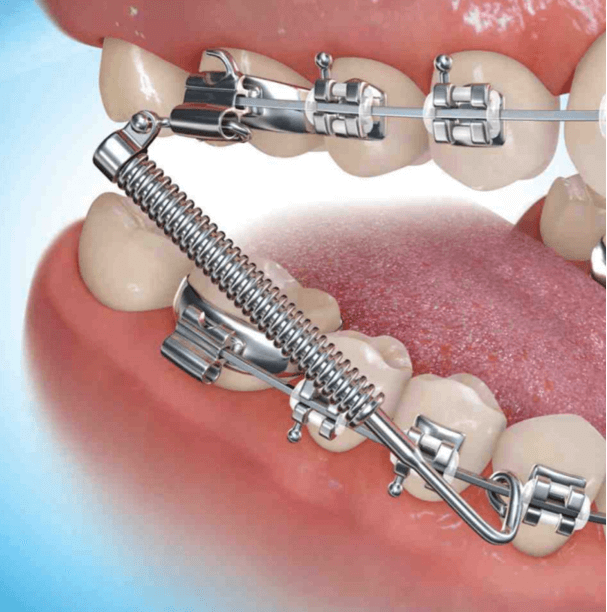Orthodontic advancements have propelled the field into a new stage, with Damon Braces standing out as an attestation to restructuring and virtue in teeth calibration. Mapped out to discourse the limitations of orthodox braces, Metal and ceramic braces propound a trailblazing solution that synthesizes aesthetics, easement, and competence. Read more about Damon Braces and their benefits in our article.
Metal Springs in Braces

Various functions aid in the gradual realignment of teeth. These recoil springs are strategically placed within the braces framework to apply controlled pressure and facilitate tooth movement. Whether it’s correcting mispositioning, fastening gaps, or calibrating bite variance, metal springs find a pivotal role in achieving desired orthodontic outcomes.
Braces with Metal Springs
When orthodontic management entails braces with metal springs, the convalescent experiences unequivocal assistance and challenges. Finding out the mastery of the metal springs task work within the structure of the brace can provide insight into the treatment process and expectations.
Metal springs employ lenient pressure on particular teeth, leading the way for them to welcome alignment over a period of time. By applying dependable strength, these springs help inscription cram issues, revolve misaligned teeth, and create capacity for conventional alignment. The controlled movement facilitated by metal springs ensures gradual and precise adjustments, leading to improved dental alignment.
Braces with Metal Springs Adjustments and Expectations

As bite discrepancies exist, metal springs in braces can aid in bite rectification. By petitioning targeted pressure on individual teeth or tooth classification, these springs oblige in position the upper and lower jaws for a tuneful site link. Whether addressing overbites, underbites, or crossbites, metal springs contribute to achieving optimal occlusion and functional bite patterns.
The inclusion of metal springs in braces builds up the ambidexterity of the orthodontic treatment school of thought. We can design the layout and tension of these springs based on individual patient needs and treatment goals. This flexibility allows for tailored treatment plans that address unique dental issues and ensure optimal outcomes.
While metal springs play a huge part as a vital role in treatment, patients will encounter some aches, pains, or annoyance, particularly during the initial adjustment period. However, growth in orthodontic automation has led to the expansion of more pleasant braces apparatus that curtail tenderness analogous with metal springs. We provide patients with a blueprint to assuage pain and ensure a less-of-a-hassle awareness.
Conventional perpetuation of metal springs is essential for ensuring the effectiveness of orthodontic treatment. Patients must adhere to hygiene protocols outlined by their orthodontist, including streamlined brushing, flossing, and avoiding certain foods that can damage the braces components. Additionally, attending scheduled inpatient sessions allows for monitoring of treatment progress and adjustments to the metal springs as needed.
The duration of orthodontia treatment with braces highlights metal springs fluctuate dependent on the convolution of the occasion and the desired treatment result. While some patients may achieve their desired results within a relatively short timeframe, others may require more extensive treatment to address complex dental issues comprehensively. Orthodontists work closely with patients to establish realistic treatment timelines and milestones.
Metal springs are requisite constituents of braces, contributing to the value and exactness of orthodontia treatment. Whether aiding in tooth alignment, bite correction, or treatment flexibility, these springs play a significant role in guiding teeth into their desired positions. Understanding the function and importance of metal springs in braces can empower patients to actively participate in their trek and achieve lasting oral health benefits.
Patient compliance is crucial for the success of orthodontia treatment with braces featuring metal springs. Adjusting to the mandate concerning wearing passage, contrivance care, and dietary diminution is all-important for carrying through peak ramifications. Outpatients must put on their braces persistently as authorized, inclusive of any accessory implementation such as elastics or headgear. Securing the desired tooth gesture and calibration. Coherence to the reception outline and seeing to orderly sessions for adjustments and progress evaluations are vital aspects of patient compliance.
Braces are not ordinary, everyone can wear the same size approach, and each patient’s treatment plan is tailored to their specific dental needs and goals. We will carefully assess components such as tooth sequence, jaw association, facial composition, and patient preferences when designing individualized treatment plans. The inclusion of metal springs in braces allows for the design of treatment mechanics, establishing that everyone sustains individualized safekeeping that dissertation their distinctive challenges.
Calls for schedules and devotional day-to-day needs, and the long-term benefits extend far beyond achieving a straighter smile. Suitably lining up teeth and rectifying bite themes give an upgrade in health, role, and aesthetics. Patients who undergo orthodontic treatment with braces promoting metal springs often undergo magnified self-assurance and lifetime quality as they enjoy the lasting benefits of a healthy, beautiful smile. Preparing for treatment is an investment in continual and universal good health.
More information on the page: Braces in Queens, NY
Ph: 718-275-3200
100-25 Queens Blvd.
Forest Hills, NY, 11375
Cedarhurst
Phone: 516-295-2006
545 Central Avenue
Cedarhurst, NY, 11516
Brooklyn
Phone: 718-763-2080
2078 East 65th Street
Brooklyn, NY, 11234
